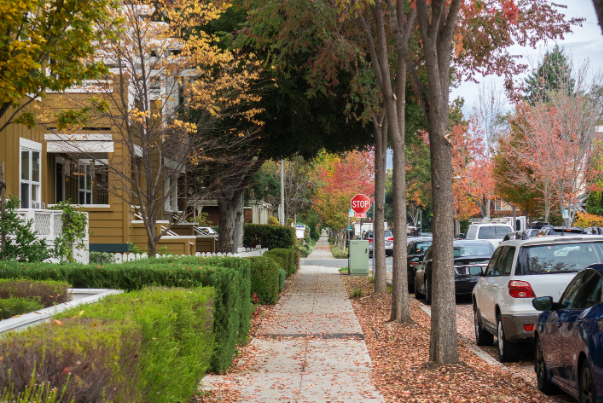Prospective homebuyers are reemerging in the housing market despite escalating interest rates. Open houses, particularly in the entry-level range of $3 million to $4 million, now draw crowds of young families. The resurgence of multiple bids is driving up home prices. For those aspiring to break into the market’s lowest echelon, that opportune moment may have slipped through their grasp.
Amid this whirlwind, however, the weekly average for a 30-year fixed-rate mortgage loan, according to Freddie Mac, has reached 7.18%, the highest level since 2002.
The good: Stabilized prices, faster sales
It appears that home prices have finally stabilized. In the first quarter of this year, the median price of a single-family home in Palo Alto plunged by 18% compared to the same time last year. In the second quarter, the decline was only 9% compared to the same period last year. By the third quarter (as of Sept. 16), the median price was $3.35 million, almost on par with $3.39 million from the same period last year.
Homes also are selling much faster compared to the beginning of the year.
The average time a property spends on the market has dwindled to 14 days during the third quarter, compared to 25 days in the first quarter of this year and 27 days during the same period last year. More than half -- 55% -- of homes are now sold above the asking price, a significant increase from approximately 33% at the beginning of this year and 47% for the same period last year. Clearly, as buyers sense an upward price trajectory, their motivation and commitment have undergone a profound shift. In September, a teardown property on an 8,000-plus-square-foot lot in Palo Alto's Midtown neighborhood that listed for around $2.9 million sold for more than $3.5 million after 19 enthusiastic buyers bid up the price by 20%.
Several factors have contributed to the market's path to recovery. In the third quarter of 2022, the market sharply plunged and hit bottom, leaving little room for further decline. The median price of a single family home sold in Palo Alto peaked in March 2022 at $4.3 million and had plummeted by 20% four months later in July. The descent continued throughout the latter part of 2022.
The low supply of houses for sale also has played a crucial role. The number of new listings on the Multiple Listing Services (MLS) tumbled by 17% year over year in the first quarter of this year. While supply surged marginally in the second quarter, it dwindled once again in late summer. As of Sept. 16, there are 15% fewer homes for sale compared to the same period last year. Practically all existing homeowners using traditional financing now possess mortgage interest rates lower than current active buyers, which could be the case even for those who made their purchase merely a week ago. Lower financing cost, coupled with lower property tax bases, has restrained homeowners from putting their properties up for sale.
The third wheel in the market's recovery has been the steady uptick in demand for housing. Our local tech economy has remained resilient, with the NASDAQ index rebounding by more than 30% from its lowest point at the end of 2022. This revival has been mostly driven by the boom in artificial intelligence and the resurgence of major tech stocks. Moreover, foreign buyers are making a comeback. In the ultra-luxury housing segment with prices above $10 million, July and August saw 18 homes go under contract in Santa Clara and San Mateo counties combined, marking the highest tally of homes sold in that price category in the past decade, surpassing the 10 recorded in the pandemic bubble in 2021.
While the overall Midpeninsula housing market is on the path to recovery, Palo Alto appears to be lagging behind its neighboring cities. Year to date, as of Sept. 16, the median price of a single-family home in Palo Alto remains down by 8% compared to a year ago. Los Altos follows closely, with a 5% decrease. On the flip side, Menlo Park's median home price is up by 8%, partially fueled by more home offerings at the upper-price spectrum. In fact, Menlo Park’s median price, which was $2.8 million in August, has exhibited a steady annual upward trend since 2020.
Cash buyers are also more prevalent in Menlo Park, constituting almost 40% of single-family transactions year to date. In Los Altos, they make up 25% of transactions, and 24% in Palo Alto. Menlo Park tends to attract a more diversified buyer pool beyond tech engineers. Among the three Midpeninsula cities, on the basis of price per square foot of living area, Palo Alto still offers the least value.
The bad: Escalating homeownership costs
Even as the housing market is recovering, numerous substantial hurdles impede a swift rebound. The first is the cost of financing. Banks are feeling the pain of the fast-rising interest rate on multiple fronts. Many lenders have declared that mortgage lending is no longer their strategically favored business and have laid off a significant portion of their loan agents. The lack of heathy competition among mortgage lenders leaves limited choices for consumers and results in higher financing cost.
Home insurance costs are also spiraling out of control. Following in the footsteps of State Farm, Allstate and Farmers Insurance, three more insurance companies have stopped writing new home polices in California, citing inadequate premiums to cover frequent natural disasters and soaring construction costs.
Even among those carriers that still offer coverage for residential homes in our area, the criteria have been significantly tightened, making it increasingly challenging for older homes with wood shingle roofs and those in rural areas to secure coverage.
Whether the residential real estate downturn is definitely in the rearview mirror remains to be seen. Nevertheless, with the economic outlook shifting upward for the coming year and a rejuvenated IPO market -- spearheaded by the recent initial public offering of chip designer ARM Holdings, which saw its stock rise nearly 25% in its first day of trading -- there appear to be fewer reasons for pessimism.
Xin Jiang is a real estate agent with Compass in Palo Alto. She can be emailed at xin.jiang@compass.com.



Comments